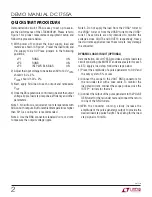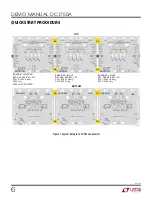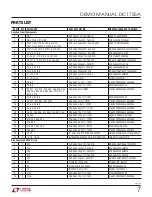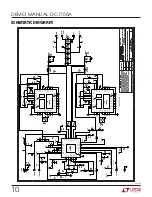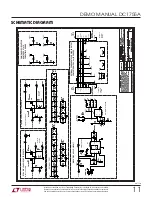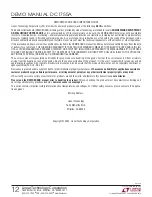
4
dc1755af
DEMO MANUAL DC1755A
Figure 2. Efficiency Curves for the 1.5V Rail of the DC1755A
Figure 3. Efficiency Curves for the 1.2V Rail of the DC1755A
Figure 4. Load Step Response of the 1.5V Rail
Figure 5. Load Step Response of the 1.2V Rail
LOAD CURRENT
(A)
0
85
80
95
DC1755a F02
10
20
30
40
60
50
75
90
EFFICIENCY (%)
V
IN
= 6V
V
IN
= 10V
V
IN
= 12V
V
IN
= 14V
LOAD CURRENT
(A)
0
85
80
95
DC1755a F03
10
20
30
40
60
50
75
90
EFFICIENCY (%)
V
IN
= 6V
V
IN
= 10V
V
IN
= 12V
V
IN
= 14V
SINGLE OUTPUT/4-PHASE OPERATION
A single output/4-phase converter may be preferred for
higher output current applications. The optional compo-
nents required to tie the phases together are found on
sheet 3 of the schematic in the lower right hand corner. To tie
the two outputs together, make the following modifications:
1) Select one rail to be the master.
a) If VOUTA is the master, then stuff 0Ω at R103 to
disable the error amplifier for VOUTB.
b) If VOUTB is the master, then stuff 0Ω at R104 to
disable the error amplifier for VOUTA.
2) Stuff 0Ω at R87, R88, R89 and R91 to tie the IAVG,
COMP, TRACK/SS and RUN signals together.
3) Remove the redundant compensation components.
6-PHASE AND 12-PHASE OPERATION
Two or more boards may be tied together for up to 12-phase
operation. To parallel two or more boards, place the boards
side by side. Connect J9 of one board to J10 of the ad-
jacent board (see sheet 3 of the schematic, lower right
hand corner). This will tie the IAVG, COMP, TRACK/SS and
DC1755a F04
25A
LOAD STEP
10A/DIV
1.5V
O
(AC)
50mV/DIV
20μs/DIV
50A
77mV
DC1755a F05
25A
LOAD STEP
10A/DIV
1.2V
O
(AC)
50mV/DIV
20μs/DIV
50A
81mV
QUICK START PROCEDURE


